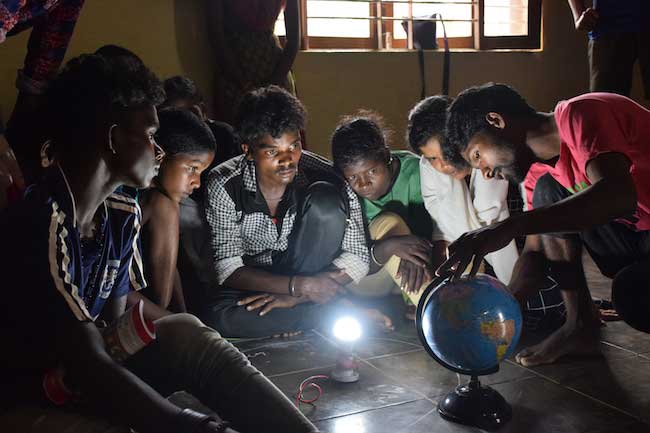
“I would urge you not to treat the issue of human rights in isolation and pay equal attention to nursing Mother Nature which is deeply wounded by the indiscretions of human beings.” – Droupadi Murmu | Speeches by the President of India >>
How the education work began – an introduction
Kadichankolli, 1991 – The first ‘school’ begins in this village. The teacher, Raji, is from the village. The medium of instruction is `Bettakurumba’. One would wonder what the significance of this is.
The Gudalur Block has as many as eleven residential schools exclusively for the tribals, called Government Tribal Residential schools (GTR Schools). Begun in the 60s, they seem to have started off well with some inspired teachers in the early years. At some point the rot had set in and in the last two decades, hardly anyone has completed schooling from these schools. The damage to the tribals has not been purely from the educational angle, but also cultural.
As it is, like this Kattunayakan boy, adivasi children go to school against heavy odds and after surmounting many obstacles. But, when they first went to the school for admission, the Headmasters straight away denigrated their names and changed them. Most of the adivasi children who have been to school have two names today. In addition to this, they are not allowed to talk in their languages. These five-year-olds would know no other language other than their mother-tongue and this really has very detrimental effect on them. They are also not used to threats and beating, and this really scares them.
Therefore, at the first opportunity, they escape from these schools, never to return. […] we took on one educated tribal youth for each of the schools. This person would be able to liaise between the community and the school, and at the same time take care of the child in the school. We also hoped that the schools would allow them to teach. This had a tremendous impact upon the community and they began to send their children to schools. However, it was not particularly well received by the teachers in the schools, who felt that we were now keeping track of them. […]
This led to the children being treated better in the schools […] Thus, in 1995, when the Mahasabha – the general meeting of 175 leaders from all the villages to assess the progress made to their lives – met, they decided that everything else had improved in these schools except the education. They felt that the only solution to this problem was to have a school of their own, just like they had a hospital of their own.
This was how the first batch of adivasi children came to Vidyodaya School. Vidyodaya School was a small private school started for the children of some of the staff of ACCORD [Action for Community Organisation, Rehabilitation and Development started in 1985] and later for some from the local community. By 1995, it was not certain whether it wanted to continue or not, as the children for whom it was started were passing out. At that juncture, the AMS expressed interest in the school and wondered whether this could not become a school for Adivasi children. […]
From a mere 43 students in 1996, we have as many as 2180 children admitted to various government and private schools today (2004-2005).
At Vidyodaya School importance is given not just to academic development of the children; Handicrafts, innovative project work, singing, dancing, drawing, painting and theatre are conducted to bring out the innate creative abilities of the children. Adivasi traditional songs, dances and story-telling are also given great importance. […]
The Trust is permitted to receive funds from foreign sources […] Indian contributors are exempt under Section 80 G of the income Tax Act.
Address: Viswa Bharati Vidyodaya Trust, Post Box No. 28,Gudalur – 643212, The Nilgiris, Tamil Nadu, India
Source: Adivasi.net – Vidyodaya
Address : http://www.adivasi.net/vidyodaya.php
Date Visited: Tue Jul 12 2011 19:58:13 GMT+0200 (CEST)
[Bold typeface added above for emphasis]
Reports in the Indian press | List of periodicals included in this search >>
Search tips
Combine the name of any particular state, language or region with that of any tribal (Adivasi) community.
Add keywords of special interest (music, poetry, dance just as health, sacred grove and biodiversity); learn about the rights of Scheduled Tribes such as the “Forest Rights Act” (FRA); and the United Nations “Declaration on the Rights of Indigenous Peoples”, “Universal Declaration of Human Rights”, “women’s rights”, or “children’s right to education”.
Ask a question that includes “tribal” or “Adivasi”, for instance: “Adivasi way of life better?” (or “tribal way of life worse?”)
Specify any particular issue or news item (biodiversity, bonded labour and human trafficking, climate change, ecology, economic development, ethnobotany, ethnomedicine, global warming, hunter-gatherers in a particular region or state, prevention of rural poverty, water access).
For official figures include “scheduled tribe ST” along with a union state or region: e.g. “Chhattisgarh ST community”, “Himalayan tribe”, “Scheduled tribe Tamil Nadu census”, “ST Kerala census”, “Particularly Vulnerable Tribal Group Jharkhand”, “PVTG Rajasthan”, “Adivasi ST Kerala”, “Adibasi ST West Bengal” etc.
In case the Google Custom Search window is not displayed here try the following: (1) toggle between “Reader” and regular viewing; (2) in your browser’s Security settings select “Enable JavaScript” | More tips >>
Note: hyperlinks and quotes are meant for fact-checking and information purposes only | Disclaimer >>

collaborative YouTube channel: Kaathadi | More resources for the classroom >>